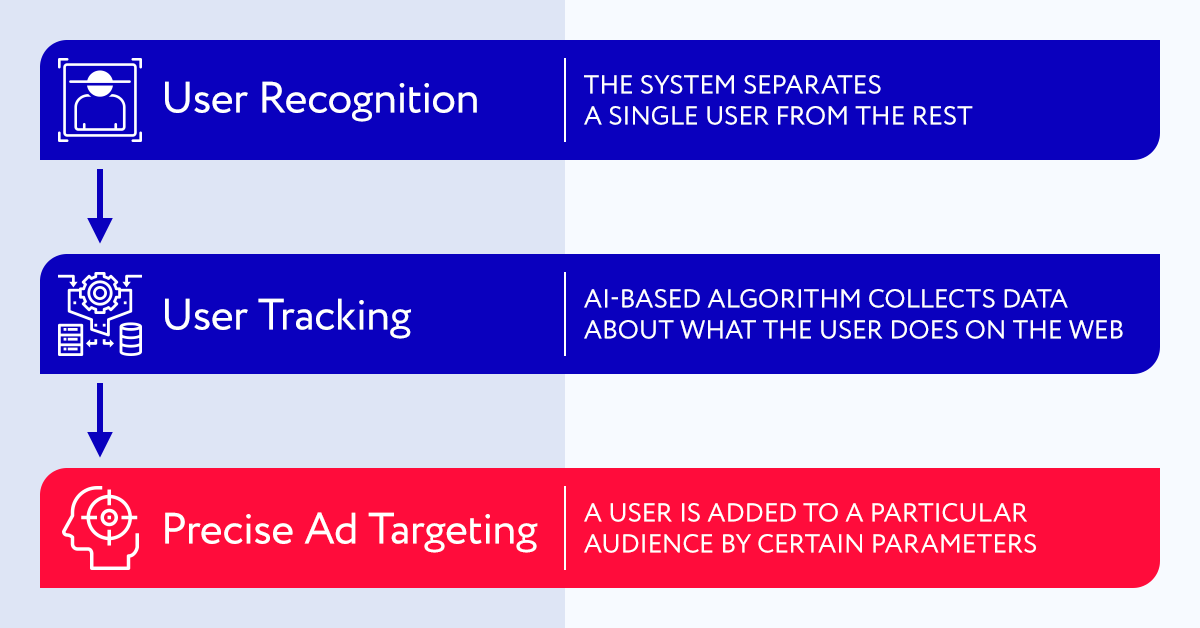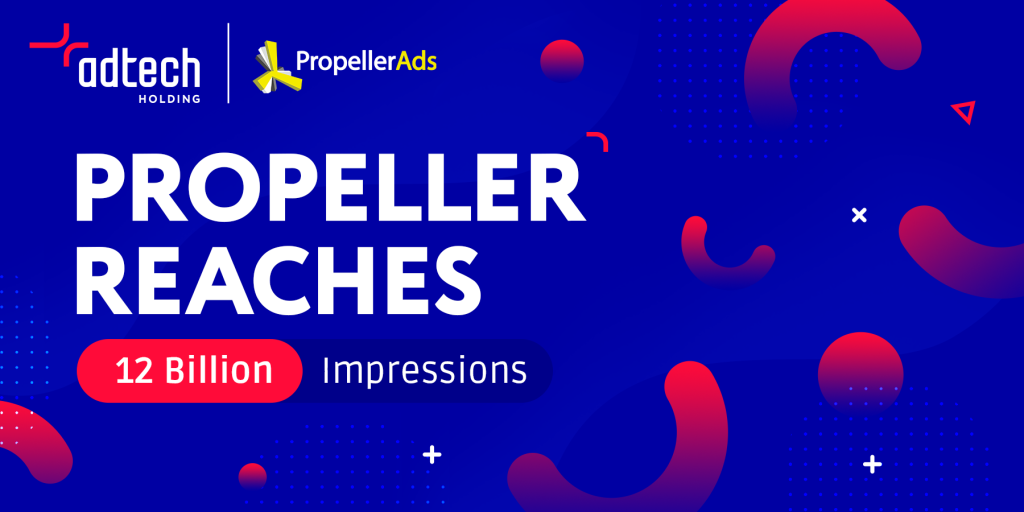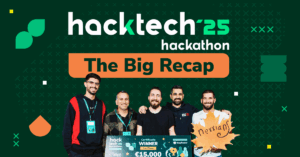Predicting User Behavior: Challenges and Opportunities

An average user sees plenty of advertising offers every day. However, it is not something random: finding the right ads for a particular user, who will most likely convert, is continuous research that includes predicting some patterns a user is stuck to.
Predicting user behavior across all digital industries basically means recognizing a user and then tracking their patterns, activities, and preferences. In programmatic advertising, the main aim of user behavior prediction is to open access to more precise ad targeting and, thus, more cost-efficient ad campaigns resulting in higher conversion rates.
In a nutshell, the process looks like this:

As a company passionate about delivering pioneering technologies for the AdTech industry, we keep our finger on the pulse of the latest tendencies related to predictive analytics of user behavior. The upcoming changes in cookie policies and other industry shifts will definitely impact all AdTech and MarTech-related businesses — but we also see plenty of opportunities in these challenges, too.
We spoke to Sergey Kozlov, Head of R&A, and revealed the answers to the burning questions about how predicting user behavior works, which technologies and solutions are used in AdTech Holding, and what is the future of user behavior prediction in programmatic advertising.
— What exactly do we predict in user behavior in the AdTech industry? What patterns are possible to predict, and how it helps?
Sergey Kozlov: When speaking about predicting user behavior for enhancing targeting in programmatic advertising, we first imply marking a particular user in our database. Here we have three options:
- 1. Marking the same user within the same ad format. For example, a user interacted with an OnClick ad once. Later, this user returned — and our technology helps us understand that this was the same unique user.
- 2. Matching users in the database across different formats. Here we have a special service that can detect a user when they, say, watched an OnClick ad and then subscribed to push notifications on the same website. In other words, this service helps to mark and remember a user even if they interact with more than one ad format.
- 3. 3rd-party cookie matching. With the help of third-party data sources and data management platforms, we can collect more precise information about a user: gender, age, etc.
— It becomes obvious that all user prediction technology is based on cookies. Thus, when Google phases out third-party cookies, the company will need to change its approach. What are the alternatives?
Sergey Kozlov: Of course, we are all aware of the upcoming so-called ‘Cookiepocalypse.’ Now, we are considering which solution based on our technology will be the best after the cookie ban — there are several options, and we haven’t stuck to the only one yet. We are constantly driving our own research based on our in-house knowledge and global decisions, like the ones discussed in the Interactive Advertising Bureau.
Anyway, thanks to our seasoned development center, we can stay flexible and make quick decisions as soon as it becomes clear what steps we need to take after third-party cookies are not available anymore.
— We will get back to challenges a bit later — and now, let’s continue discussing AdTech Holding’s current know-how. What technologies does the company use for the prediction of user behavior, and how do they help advertisers and publishers?
Sergey Kozlov: We have three approaches: one based on audiences, another related to ad rotation, and finally, user activity cohorts.
- 1. AdTech’s in-house data management platform allows us to create special user audiences. In simple words, it works like this: our algorithms track what websites a user visited and which ads they clicked. As soon as there is enough data, a user is added to the audience.
For example, the PropellerAds multisource advertising platform that uses AdTech Holding technology has audiences by interests (Sports, Shopping, Finance, iGaming, Giveaways, Dating, and Utilities).
Besides, we provide our advertisers with an opportunity to create their own audiences within the platform.
- 2. Ad rotation is related to a machine learning algorithm working based on various factors: which ads a user clicks, how a user converts, what websites at which GEOs they visit, etc. Considering such factors helps the algorithm learn and, in the end, show the most suitable and personalized ads to a particular user.
- 3. Analyzing how our clients’ ads perform, we managed to group all users into three activity cohorts: high — with users clicking the ads frequently, medium — with less active users, and low — with the most selective users.
Based on these cohorts, advertisers have an opportunity to create more precise strategies for their campaigns. For example, it makes sense to target a low-activity cohort when you need to show ads to as many people as possible but don’t want to spend too much of the budget.
To keep behavior tracking actual, we apply different learning techniques, including apparent and latent factors. For example, our AI can separate users who actively click various ads from those who don’t click them at all. Such factors are related to the apparent.
However, when we collect, say, user interest audiences, we mean latent factors: like the banners clicked by a user, which give a hint about the user interests.
— What are the main challenges AdTech Holding faces with predicting user behavior? Are there any issues when AI makes mistakes or gives predictions that are not precise enough?
Sergey Kozlov: Of course, the main challenge is the novel data anonymization measures, including the much-speculated refusal of third-party cookies. However, I wouldn’t name it an issue for AdTech Holding: our technologies are primarily aimed at using non-personalized data.
Overall, we don’t currently see a significant threat to our workflows or development and don’t experience problems with user data analysis. We use the most modern machine learning technologies that allow us to predict user behavior with the maximum possible accuracy.
— And what about the cookieless future? There anyway will be a need to change the manner of marking users, so what are the most possible changes and trends?
Sergey Kozlov: Whatever happens to third-party cookies, there will be an alternative way of user identification. So, as I have already mentioned, the question of what exactly this way will be is discussed globally — and here are some options that have all chances to replace the previous solution.
- Fingerprints
This method is based on browser information. The point is that every browser is unique in terms of various user settings and extensions. Thus, the same combination of settings within a single IP or an IP range will indicate the same user with a very high probability. Yes, this method is not the most accurate one at the moment, but it has already proven itself reliable enough to substitute third-party cookies.
- Universal Identifiers
In a nutshell, this technology implies creating universal user profiles, e.g., universal IDs. These IDs are located in Identity Graphs — databases with identifiers that help recognize a user by matching unique pieces of data. Such data can include email addresses, phone numbers, usernames, customer IDs, and more, including even some offline information like loyalty cards.
- Data Pools
This concept of networking between publishers and advertisers is based on the first-party data that website owners can collect from their users. In short, data pools will contain user data uploaded by publishers, and both sides can take part in matching this data to define unique users.
We thank Sergey for sharing information — and will keep you updated on AdTech Holding’s further development, releases, and opportunities.



